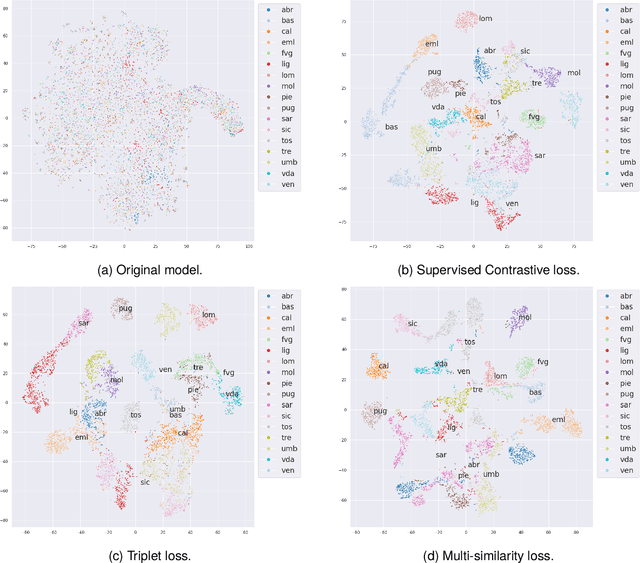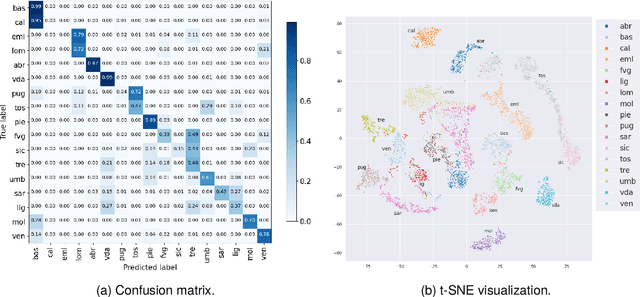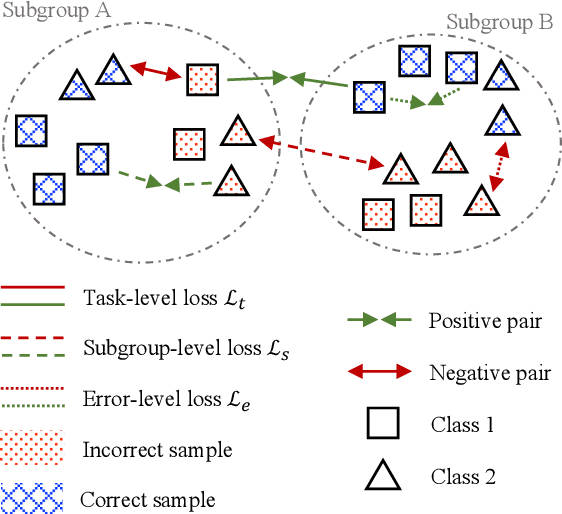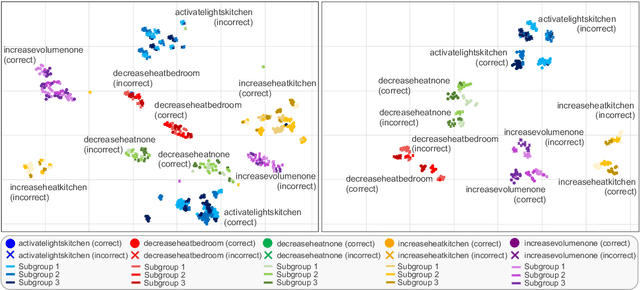Alkis Koudounas
A Concept-based approach to Voice Disorder Detection
Jul 23, 2025Abstract:Voice disorders affect a significant portion of the population, and the ability to diagnose them using automated, non-invasive techniques would represent a substantial advancement in healthcare, improving the quality of life of patients. Recent studies have demonstrated that artificial intelligence models, particularly Deep Neural Networks (DNNs), can effectively address this task. However, due to their complexity, the decision-making process of such models often remain opaque, limiting their trustworthiness in clinical contexts. This paper investigates an alternative approach based on Explainable AI (XAI), a field that aims to improve the interpretability of DNNs by providing different forms of explanations. Specifically, this works focuses on concept-based models such as Concept Bottleneck Model (CBM) and Concept Embedding Model (CEM) and how they can achieve performance comparable to traditional deep learning methods, while offering a more transparent and interpretable decision framework.
MVP: Multi-source Voice Pathology detection
May 26, 2025Abstract:Voice disorders significantly impact patient quality of life, yet non-invasive automated diagnosis remains under-explored due to both the scarcity of pathological voice data, and the variability in recording sources. This work introduces MVP (Multi-source Voice Pathology detection), a novel approach that leverages transformers operating directly on raw voice signals. We explore three fusion strategies to combine sentence reading and sustained vowel recordings: waveform concatenation, intermediate feature fusion, and decision-level combination. Empirical validation across the German, Portuguese, and Italian languages shows that intermediate feature fusion using transformers best captures the complementary characteristics of both recording types. Our approach achieves up to +13% AUC improvement over single-source methods.
Exploring Generative Error Correction for Dysarthric Speech Recognition
May 26, 2025Abstract:Despite the remarkable progress in end-to-end Automatic Speech Recognition (ASR) engines, accurately transcribing dysarthric speech remains a major challenge. In this work, we proposed a two-stage framework for the Speech Accessibility Project Challenge at INTERSPEECH 2025, which combines cutting-edge speech recognition models with LLM-based generative error correction (GER). We assess different configurations of model scales and training strategies, incorporating specific hypothesis selection to improve transcription accuracy. Experiments on the Speech Accessibility Project dataset demonstrate the strength of our approach on structured and spontaneous speech, while highlighting challenges in single-word recognition. Through comprehensive analysis, we provide insights into the complementary roles of acoustic and linguistic modeling in dysarthric speech recognition
"KAN you hear me?" Exploring Kolmogorov-Arnold Networks for Spoken Language Understanding
May 26, 2025



Abstract:Kolmogorov-Arnold Networks (KANs) have recently emerged as a promising alternative to traditional neural architectures, yet their application to speech processing remains under explored. This work presents the first investigation of KANs for Spoken Language Understanding (SLU) tasks. We experiment with 2D-CNN models on two datasets, integrating KAN layers in five different configurations within the dense block. The best-performing setup, which places a KAN layer between two linear layers, is directly applied to transformer-based models and evaluated on five SLU datasets with increasing complexity. Our results show that KAN layers can effectively replace the linear layers, achieving comparable or superior performance in most cases. Finally, we provide insights into how KAN and linear layers on top of transformers differently attend to input regions of the raw waveforms.
DeepDialogue: A Multi-Turn Emotionally-Rich Spoken Dialogue Dataset
May 26, 2025Abstract:Recent advances in conversational AI have demonstrated impressive capabilities in single-turn responses, yet multi-turn dialogues remain challenging for even the most sophisticated language models. Current dialogue datasets are limited in their emotional range, domain diversity, turn depth, and are predominantly text-only, hindering progress in developing more human-like conversational systems across modalities. To address these limitations, we present DeepDialogue, a large-scale multimodal dataset containing 40,150 high-quality multi-turn dialogues spanning 41 domains and incorporating 20 distinct emotions with coherent emotional progressions. Our approach pairs 9 different language models (4B-72B parameters) to generate 65,600 initial conversations, which we then evaluate through a combination of human annotation and LLM-based quality filtering. The resulting dataset reveals fundamental insights: smaller models fail to maintain coherence beyond 6 dialogue turns; concrete domains (e.g., "cars," "travel") yield more meaningful conversations than abstract ones (e.g., "philosophy"); and cross-model interactions produce more coherent dialogues than same-model conversations. A key contribution of DeepDialogue is its speech component, where we synthesize emotion-consistent voices for all 40,150 dialogues, creating the first large-scale open-source multimodal dialogue dataset that faithfully preserves emotional context across multi-turn conversations.
"Alexa, can you forget me?" Machine Unlearning Benchmark in Spoken Language Understanding
May 21, 2025Abstract:Machine unlearning, the process of efficiently removing specific information from machine learning models, is a growing area of interest for responsible AI. However, few studies have explored the effectiveness of unlearning methods on complex tasks, particularly speech-related ones. This paper introduces UnSLU-BENCH, the first benchmark for machine unlearning in spoken language understanding (SLU), focusing on four datasets spanning four languages. We address the unlearning of data from specific speakers as a way to evaluate the quality of potential "right to be forgotten" requests. We assess eight unlearning techniques and propose a novel metric to simultaneously better capture their efficacy, utility, and efficiency. UnSLU-BENCH sets a foundation for unlearning in SLU and reveals significant differences in the effectiveness and computational feasibility of various techniques.
voc2vec: A Foundation Model for Non-Verbal Vocalization
Feb 22, 2025



Abstract:Speech foundation models have demonstrated exceptional capabilities in speech-related tasks. Nevertheless, these models often struggle with non-verbal audio data, such as vocalizations, baby crying, etc., which are critical for various real-world applications. Audio foundation models well handle non-speech data but also fail to capture the nuanced features of non-verbal human sounds. In this work, we aim to overcome the above shortcoming and propose a novel foundation model, termed voc2vec, specifically designed for non-verbal human data leveraging exclusively open-source non-verbal audio datasets. We employ a collection of 10 datasets covering around 125 hours of non-verbal audio. Experimental results prove that voc2vec is effective in non-verbal vocalization classification, and it outperforms conventional speech and audio foundation models. Moreover, voc2vec consistently outperforms strong baselines, namely OpenSmile and emotion2vec, on six different benchmark datasets. To the best of the authors' knowledge, voc2vec is the first universal representation model for vocalization tasks.
Speech Analysis of Language Varieties in Italy
Jun 22, 2024



Abstract:Italy exhibits rich linguistic diversity across its territory due to the distinct regional languages spoken in different areas. Recent advances in self-supervised learning provide new opportunities to analyze Italy's linguistic varieties using speech data alone. This includes the potential to leverage representations learned from large amounts of data to better examine nuances between closely related linguistic varieties. In this study, we focus on automatically identifying the geographic region of origin of speech samples drawn from Italy's diverse language varieties. We leverage self-supervised learning models to tackle this task and analyze differences and similarities between Italy's regional languages. In doing so, we also seek to uncover new insights into the relationships among these diverse yet closely related varieties, which may help linguists understand their interconnected evolution and regional development over time and space. To improve the discriminative ability of learned representations, we evaluate several supervised contrastive learning objectives, both as pre-training steps and additional fine-tuning objectives. Experimental evidence shows that pre-trained self-supervised models can effectively identify regions from speech recording. Additionally, incorporating contrastive objectives during fine-tuning improves classification accuracy and yields embeddings that distinctly separate regional varieties, demonstrating the value of combining self-supervised pre-training and contrastive learning for this task.
A Contrastive Learning Approach to Mitigate Bias in Speech Models
Jun 20, 2024



Abstract:Speech models may be affected by performance imbalance in different population subgroups, raising concerns about fair treatment across these groups. Prior attempts to mitigate unfairness either focus on user-defined subgroups, potentially overlooking other affected subgroups, or do not explicitly improve the internal representation at the subgroup level. This paper proposes the first adoption of contrastive learning to mitigate speech model bias in underperforming subgroups. We employ a three-level learning technique that guides the model in focusing on different scopes for the contrastive loss, i.e., task, subgroup, and the errors within subgroups. The experiments on two spoken language understanding datasets and two languages demonstrate that our approach improves internal subgroup representations, thus reducing model bias and enhancing performance.
Voice Disorder Analysis: a Transformer-based Approach
Jun 20, 2024



Abstract:Voice disorders are pathologies significantly affecting patient quality of life. However, non-invasive automated diagnosis of these pathologies is still under-explored, due to both a shortage of pathological voice data, and diversity of the recording types used for the diagnosis. This paper proposes a novel solution that adopts transformers directly working on raw voice signals and addresses data shortage through synthetic data generation and data augmentation. Further, we consider many recording types at the same time, such as sentence reading and sustained vowel emission, by employing a Mixture of Expert ensemble to align the predictions on different data types. The experimental results, obtained on both public and private datasets, show the effectiveness of our solution in the disorder detection and classification tasks and largely improve over existing approaches.
 Add to Chrome
Add to Chrome Add to Firefox
Add to Firefox Add to Edge
Add to Edge